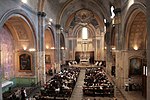Triumphal Arch of Orange

The Triumphal Arch of Orange (French: Arc de triomphe d'Orange) is a triumphal arch located in the town of Orange, southeast France. There is debate about when the arch was built, but current research that accepts the inscription as evidence favours a date during the reign of emperor Augustus (27 BC–AD 14). It was built on the former via Agrippa to honor the veterans of the Gallic Wars and Legio II Augusta. It was later reconstructed by emperor Tiberius to celebrate the victories of Germanicus over the German tribes in Rhineland. The arch contains an inscription dedicated to emperor Tiberius in AD 27. Along with the Roman Theatre of Orange, the Triumphal Arch was inscribed on the UNESCO World Heritage List in 1981 because of its exceptional preservation.
Excerpt from the Wikipedia article Triumphal Arch of Orange (License: CC BY-SA 3.0, Authors, Images).Triumphal Arch of Orange
Rond-Point de l'Arc de Triomphe, Carpentras
Geographical coordinates (GPS) Address Nearby Places Show on map
Geographical coordinates (GPS)
| Latitude | Longitude |
|---|---|
| N 44.141916666667 ° | E 4.8050833333333 ° |
Address
Rond-Point de l'Arc de Triomphe
84100 Carpentras, Portail Lançon
Provence-Alpes-Côte d'Azur, France
Open on Google Maps










